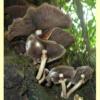
images/Agrocybe/Agrocybe2.jpg
Small to very large agaric, growing on the ground, litter or mulch, wood or dung, with a dark brown spore print. Pileus pale, yellow or brown, dry, moist or viscid. Lamellae adnexed, adnate, sinuate or subdecurrent. Stipe central, rarely excentric. Partial veil remnants a ring zone, a membranous annulus or absent. Spores pale or yellow-brown, non-amyloid, smooth; germ pore narrow or broad. Basidia 2- or 4-spored. Cheilocystidia present; pleurocystidia often present. Lamellar trama regular. Pileipellis a hymeniderm or rarely appearing to be a cutis when hyphal fragments are embedded in gelatinous matrix. Clamp connections present or absent.
Among brown-spored agarics that are not deliquescent this genus is distinguished by the rather dark brown (hazel, snuff or umber-brown) spore print and the smooth, generally thick-walled spores, with germ pore (rarely absent in some extra-Australian species) along with the hymeniderm pileipellis. Fruit-bodies are pale or some shade of yellow or brown (never brightly coloured). The pileus is relatively smooth, and can become areolate (cracked) with age. There is considerable variation in the development of the partial veil, from absent to forming a ring zone or an evident membranous annulus.
Conocybe and
Pholiotina share the hymeniderm pileipellis, but have a rust-brown to cinnamon spore print. In
Bolbitius the pileus is viscid and most often very pale or bright yellow, and the fruit-body is rather thin and fragile.
Psilocybe and
Pholiota can have similar spore-print colours, and smooth, thick-walled spores, but the pileus is often viscid and the pileipellis is a cutis rather than a hymeniderm. In addition,
Pholiota has chrysocystidia.
Psathyrella generally has a darker (to black) spore print and the fruit-bodies are usually rather fragile.
Agrocybe Fayod, Ann. Sci. Nat., Bot., sér. 7, 9: 358 (1889).
About a dozen species:
Agrocybe arenicola,
A. cylindrica,
A. limonia,
A. mullauna,
A. neocoprophila,
A. olida,
A. parasitica (large pileus, well-developed annulus, growing on trees in wet forest),
A. pediades,
A. praecox (common on wood chip mulch, pileus often cracking with age),
A. semiorbicularis and
A. tunicola.
Agrocybe parrumbula is excluded because the spore print is described by Grgurinovic (1997) as "dark purplish brown", whereas Agrocybe has a dark brown print. Perhaps that species belongs in Psathyrella.
W.A., S.A., Qld, N.S.W., Vic. and Tas. (and probably also N.T.).
In native forests, and also commonly in parks and gardens and along roadsides.
On the ground, on wood, litter or mulch, or sometimes on dung.
Saprotrophic.
Bougher, N.L. (2009a),
Fungi of the Perth region and beyond: a self-managed field book, Western Australian Naturalists' Club (Inc.), Perth. [
Description and
Illustration of
A. pediades]
Breitenbach, J. & Kränzlin, F. (eds) (1995), Fungi of Switzerland. Volume 4. Agarics 2nd part. Edition Mykologia, Lucerne. [Description, Microcharacters and Illustration of eleven Swiss species, including A. cylindrica, A. praecox and A. semiorbicularis]
Fuhrer, B. (2005), A Field Guide to Australian Fungi. Bloomings Books, Hawthorn. [Description and Illustration of A. parasitica and A. praecox]
Fuhrer, B. & Robinson, R. (1992), Rainforest Fungi of Tasmania and South-east Australia. CSIRO Press, East Melbourne. [Illustration of A. parasitica]
Grgurinovic, C.A. (1997a), Larger Fungi of South Australia. The Botanic Gardens of Adelaide and State Herbarium and The Flora and Fauna of South Australia Handbooks Committee, Adelaide. [Description and Microcharacters of A. limonia, A. mullauna and A. tunicola, and Key to South Australian species]
Hood, I.A. (2003), An Introduction to Fungi on Wood in Queensland. University of New England, School of Environmental Sciences and Natural Resources Management, Armidale. [Description and B&W Illustration of A. parasitica]
McCann, I.R. (2003), Australian Fungi Illustrated. Macdown Productions, Vermont. [Illustration of A. praecox]
Pegler, D.N. (1965), Studies on Australasian Agaricales, Austral. J. Bot. 13: 323–356. [brief Microcharacters of A. limonia and A. olida]
Stevenson, G. (1982), A parasitic member of the Bolbitiaceae, Agrocybe parasitica sp. nov., New Zealand J. Forest. 27: 130–133. [Description, B&W Illustration and Microcharacters of A. parasitica]
Watling, R. (1982), British Fungus Flora. Agarics and Boleti. 3 / Bolbitaceae: Agrocybe, Bolbitius & Conocybe. Royal Botanic Garden, Edinburgh. [Description, B&W Illustration and Microcharacters of A. cylindrica, A. praecox and A. semiorbicularis and numerous other species along with Key to British species]
Watling, R. & Taylor, G.M. (1987), Observations on the Bolbitiaceae: 27. Preliminary account of the Bolbitiaceae of New Zealand, Biblioth. Mycol. 117: 1–61. [Description, Microcharacters and B&W Illustration of A. parasitica and A. praecox and Key to the eleven New Zealand species]





_AE_05_sml.jpg)
